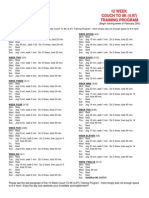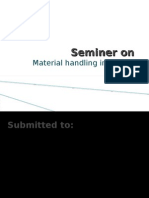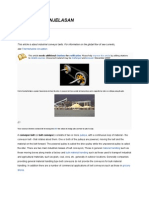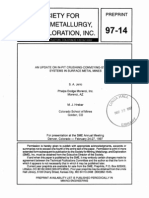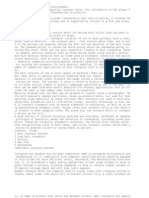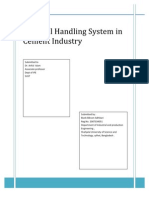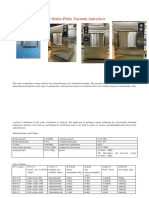Dangote Cement
Dangote Cement
Uploaded by
Robel FirewCopyright:
Available Formats
Dangote Cement
Dangote Cement
Uploaded by
Robel FirewOriginal Description:
Original Title
Copyright
Available Formats
Share this document
Did you find this document useful?
Is this content inappropriate?
Copyright:
Available Formats
Dangote Cement
Dangote Cement
Uploaded by
Robel FirewCopyright:
Available Formats
College of Electrical and Mechanical Engineering,
Department of Mechanical Engineering
Material Handling Project
Apron Chain Conveyor
Dangote Cement
Group 6
1. ABEL GEBREMICHAEL ETS0025/12
2. ABEMELEK TEFERA ETS0036/12
3. EYOEL ASCHALEW ETS0272/12
4. HOSAINA SOLOMON ETS0362/12
5. MICHAEL DEREBIE ETS0462/12
6. MICHAEL GETU ETS0461/12
SUBMIITED TO: Aregawi G. (Assistant Professor)
Table of Contents
Introduction: Apron chain conveyor ............................................................................................................. 1
Background of Dangote Cement ................................................................................................................... 2
Objective ....................................................................................................................................................... 3
Literature Review .......................................................................................................................................... 3
Principle of operations .................................................................................................................................. 4
Function of Apron chain Conveyor .............................................................................................................. 5
Design Considerations Apron Chain Conveyor ............................................................................................ 5
Methodology: Parameter design .................................................................................................................. 6
3D modeling for the Drive unit ..................................................................................................................... 7
Carry structure .............................................................................................................................................. 8
Design for the Component .......................................................................................................................... 11
Conclusion .................................................................................................................................................. 20
Reference .................................................................................................................................................... 20
Introduction: Apron chain conveyor
Apron chain conveyor is a type of conveyor system that is commonly used in industrial settings
to transport heavy materials, such as bulk materials, minerals, and other types of materials that
require a robust and durable conveyor system. The conveyor system consists of a series of
overlapping metal plates, or aprons that are connected by chains and driven by a motor. The
aprons are typically made of steel or other durable materials and are designed to withstand the
weight and pressure of the materials being transported.
The apron chain conveyor is a popular choice for many industrial applications due to its ability to
handle heavy loads and its durability. It is commonly used in industries such as mining,
construction, and manufacturing, where heavy materials need to be transported over long
distances. The conveyor system can be customized to meet the specific needs of the application,
including the length of the conveyor, the width of the aprons, and the speed of the conveyor.
Apron Conveyors are ideal for moving product horizontally and up inclines. They are
extensively used to handle bulk materials such as cement/clinker, ore, sand, gravel, stone, coal,
foundry/castings, industrial refuse and a variety of similar materials for light, medium, and
heavy-duty applications.
Figure 1: Apron chain Conveyor
[Type text] Page 1
Figure 2: Apron chain Conveyor components
Aprons are mounted with attachments at both sides of conveyor chain and the carried objects put
on the apron are conveyed as the conveyor chain moves forwards. This apron is normally made
by steel plate and the curried stuffs are put on the plate and conveyed. It makes possible to
convey steep slope by attaching frames to the aprons. Also, carried stuffs will not fall out from
its side edges by attaching side guards. However, conveying speed is slow since it is transported
with conveyor chain. The price is more expensive compared with other belt conveyors as well.
Despite of these disadvantages, there are still many situations that only the apron conveyor can
manage since the conveyor has advantages in specific environment.
There are two types of apron
1) Bended steel plate: - Steel plates are bended as their front and back are overlapped. The plate
needs to be put ingeniously to prevent the stuffs from falling out even the stuffs are powdery.
2) Steel plates connected by hinge: - Front steel plate is connected to back steel plates with
hinges. Both plates are connected and can move freely as well. This shape is worked out for the
purpose of preventing the conveyed stuffs from falling down from apron plate. This is more
expensive than bended steel plate type apron plates.
Background of Dangote Cement
One of the key businesses required for sustainable growth is the cement industry. It could be
viewed as the foundation for development.
[Type text] Page 2
Conveying technology for the cement industry used different type such as troughed Belt
Conveyors, Pipe Conveyors, Belt Bucket Elevators, Apron chain Conveyors, Belt Apron
Conveyors, Alternative Fuel Conveyor. As mention in the introduction we design apron chain
conveyors from other conveyors for our plant to employ in moving limestone, the raw material,
to the crushing and grinding unit. This process is found in cement manufacturing is after mining
and grinding of raw materials. Limestone and clay-containing materials are ground into a fine
powder known as raw meal, which is then fired in a cement kiln to a sintering temperature of up
to 1450 °C. The source components' chemical bonds are weakened during this procedure, after
which they are mixed to form new molecules. The result is called clinker, which are rounded
nodules between 1mm and 25mm across. The clinker is ground to a fine powder in a cement mill
and mixed with gypsum to create cement.
There are four stages in the manufacture of cement: crushing and grinding the raw materials,
blending the materials in the correct proportions, burning the prepared mix in a kiln, and
grinding the burned product, known as ―clinker,‖ together with some 5 percent of gypsum (to
control the time of set of the cement) In each stage we may use different kind of conveyors for
transporting the materials.
Objective
To design apron chain conveyor that is used in the handling process of cement factory
To make the necessary calculations to make design the apron chain conveyor
To make the 3D model for the Apron chain conveyor based on the calculated parameters
To make analysis of the 3D model by using CATIA
Literature Review
Apron conveyors are an essential part of the material handling industry. It is a machine that is
used for transporting materials, including heavy, abrasive, and hot materials, along an
inclined or horizontal path. It is typically used in industries like mining, cement, and
fertilizer. The primary purpose of an apron conveyor is to move materials from one place to
the other, making it one of the most indispensable machines in the material handling
industry. The literature on apron conveyors highlights the several features and benefits of
using the machine. Researchers have noted that the high durability and resistance to wear and
tear make the apron conveyor ideal for handling abrasive materials. The conveyors' inclined
form factor also ensures the efficient movement of bulk materials, reducing operational
downtime. Further, the apron conveyor's adaptability to both horizontal and inclined
positions enhances the machine's versatility, making it more efficient for various
applications. Most literature on apron conveyors also highlights the importance of regular
maintenance to ensure optimal performance and prolong the lifespan of the machine.
According to studies, factors like inadequate lubrication, overloading, and worn-out parts can
easily cause apron conveyors to break down. Therefore, it is essential to perform regular
[Type text] Page 3
inspections of the machine's components and promptly replace any worn-out or damaged
parts to prevent costly repairs and reduce downtime. In conclusion, the literature on apron
conveyors provides essential insights into the workings and applications of the machine.
Several studies have demonstrated the machine's versatility, reliability, and efficiency in
handling abrasive and bulk materials across various industries. However, to ensure optimal
performance and prolong the machine's lifespan, regular maintenance is crucial. With
continued research and development, apron conveyors' performance is expected to continue
improving while contributing immensely to the material handling industry.
Principle of operations
The operation principle involves the use of a double chain drive on which Steel plates are bolted
forming the supporting and transporting surface that moves material. The characteristics of the
plates of single machine depend on the flow rate, size as well as temperature of conveyed
material and also inclination of the conveyor. Apron conveyors are specifically adapted to
convey heavy, lumpy and abrasive material. It not only helps in the prevention of surge loads to
primary crushers, belt conveyors or other equipment, but also plays a great role in ensuring that
if sprocket starts running on head, traction chain in pan-chain device meshes with sprocket roller
travels along track fixed on frame and drive entire pans to move along longitudinal centerline the
meantime the material is transported along conveying line towards the front of body for
continuous and uniform convening. After the apron feeder is started, the motor outputs the
driving force according to the rated power, which is converted into the driving force with large
torque after the speed change of the coupling and reducer. The driving force is transferred to the
spindle device through the locking disc, and the traction force is transferred to the chain plate
device to carry the material through the sprocket wheel on the spindle device. It uses the pitch of
228.6 mm (9 inches) high strength bulldozer die forging chain for traction, two chain around
installed in the head of a driven sprocket and body got behind a pair of tension wheel at the end
of the closed-loop, in two rows of chain assembly on the each link of overlap each other, the
transport of heavy structure trough and become a continuous to carry material conveying line.
The deadweight and the weight of materials are supported by the multi-row supporting wheel,
chain supporting wheel and slide beam mounted on the body. The drive system is connected to
the reducer by the ac frequency conversion speed regulating motor, and then the carrier
mechanism is driven at low speed by the expansion sleeve and the drive device. The materials
discharged from the tail bin are transported to the front of the body along the conveying line and
discharged, to realize the purpose of continuous and uniform feeding to the working machinery
below.
[Type text] Page 4
Function of Apron chain Conveyor
An apron chain conveyor is an essential component in a cement factory, as it is responsible for
transporting raw materials and finished products throughout the production process. This type of
conveyor is designed to handle heavy loads and operate in harsh environments, making it ideal
for use in the cement industry.
The apron chain conveyor consists of a series of overlapping metal plates, or aprons, that are
connected by chains. The aprons are typically made of steel and are designed to withstand the
abrasive and corrosive nature of cement materials. The chains are driven by a motor, which
moves the aprons along the conveyor track.
In a cement factory, the apron chain conveyor is used to transport raw materials such as
limestone, clay, and sand from the quarry to the production facility. Once the raw materials are
processed into cement, the conveyor is used to transport the finished product to storage silos or
to the loading dock for shipment.
The apron chain conveyor is also used to transport other materials such as coal, gypsum, and
additives that are used in the cement production process. These materials are typically stored in
large silos and are transported to the production facility as needed.
The Apron chain conveyor also helps to minimize the risk of accidents in the cement factory.
The use of the conveyor in transferring materials eliminates the need for workers to handle heavy
materials manually. This significantly reduces the risk of accidents that can occur during the
production process. The Apron chain conveyor also operates quietly, which helps to ensure a
comfortable working environment for all workers. Apron chain conveyor system in a cement
factory requires less maintenance compared to other types of conveyors. The system is designed
to operate under harsh conditions and can withstand the harsh environmental conditions in a
cement factory. This reduces the downtime required for maintenance, which contributes to the
overall efficiency of the production process
Overall, the apron chain conveyor plays a critical role in the cement production process, ensuring
that raw materials and finished products are transported efficiently and safely throughout the
factory.
Design Considerations Apron Chain Conveyor
1. Type of Raw Materials being transported is an important consideration in the design of an
apron chain conveyor. The conveyor must be designed to handle the weight and size of the raw
materials. For example, limestone is a heavy material, and the conveyor must be designed to
handle its weight.
2. Distance between Quarry and Cement Plant is another important consideration in the
design of an apron chain conveyor. The conveyor must be designed to transport the raw materials
efficiently over the distance. The conveyor must also be designed to operate in harsh
environments, such as dusty and humid conditions.
[Type text] Page 5
3. Capacity of the Conveyor is another important consideration in the design of an apron chain
conveyor. The conveyor must be designed to transport the required amount of raw materials to
the cement plant. The capacity of the conveyor is determined by the size of the aprons, the speed
of the conveyor, and the power of the motor.
4. Dust Suppression Systems are an important consideration in the design of an apron chain
conveyor. The conveyor must be designed to prevent the release of dust into the environment,
which can be harmful to workers and the surrounding community. The conveyor must be
equipped with dust suppression systems, such as water sprays or dust collectors.
5. Maintenance is an important consideration in the design of an apron chain conveyor. The
conveyor must be designed to be easily maintained, with access points for cleaning and
inspection. The conveyor must also be designed to be easily repaired, with spare parts readily
available.
6. Power Requirements of the conveyor system must be considered when designing the system.
The conveyor must be designed to operate efficiently and minimize energy consumption.
7. Cost of the conveyor system must be considered when designing the system. The conveyor
must be designed to be cost-effective and provide a good return on investment.
Methodology: Parameter design
Critical Data assumptions
Apron: 1000mm ( 39.37 in) wide pans
Length: 10m, 30-ft centers.
Material: limestone weighing 2075kg/m3, 3-in. lumps
Capacity: 350TPH
Conveyor: horizontal feeder, only 80% of cross-section filled
[Type text] Page 6
3D modeling for the Drive unit
Figure 3: Motor
Figure 4: Drive Sprocket & Tail wheel
[Type text] Page 7
Carry structure
Figure 5: Support
Figure 6: Support 2
[Type text] Page 8
Figure 7: Support 3
Figure 8: Apron Pans
[Type text] Page 9
Figure 9: Chain
Figure 10: Carrying Rollers
ASSEMBLY
[Type text] Page 10
Figure 11: Assembled Apron Chain Conveyor
Design for the Component
Chain speed
The chain speed is the speed at which the chain moves and drives the pans. It is calculated based
on the capacity of the conveyor, the cross-sectional area of the material being conveyed, and the
density of the material. The chain speed must be sufficient to move the material at the required
rate without causing excessive wear or damage to the conveyor components.
W= 1m *0.15m * 0.80 * 2075 kg/m3 = 249kg/m =167.32 lb. /ft.
W = 33.33 X TPH/V
V = 33.33 X TPH/W
= 33.33 X 350/167.32
= 69.72 ft. /m
= 0.3541776 m/s
Volume flow rate
The volume flow rate is the rate at which the material is being conveyed. It is calculated based
on the capacity of the conveyor and the density of the material. The volume flow rate is
[Type text] Page 11
important for determining the size and capacity of the conveyor components, such as the pans
and chain.
Volume flow rate = capacity / material density
qv = Capacity/ρ
Volume flow rate = 350,000 / 2570 = 168.67m3/h
For 80% of the occupied volume
= 0.8*168.67m3/h
= 135 m3/h
Chain Tension
Horizontal—conveying side and return side supporter
𝑃 = (2.1𝑀𝑓𝑚 + 𝑊𝑓𝑤) 𝐶 +0.5P+ 𝐽
P = conveyor chain pull
W = 167.32 lb. /ft.
Where V is the chain speed (FPM) = 0.3541776 m/s
TPH is the capacity.
M = weight of conveying elements, chain, and other moving parts per distance.
[Type text] Page 12
Weight of apron =56lb/ft
Correction factor of 5.3 for every 6in
[Type text] Page 13
39.37-18=21.37
21.37/6=3.561
So, 3.561*5.3=18.9lb/ft correction
Total weight
=56+18.9
= 74.9 lb. /ft = 111.4635 kg/m
Coefficient of friction is,
𝑓𝑚 = 0.110 = 𝑓w
𝑃1 = 2𝑓𝑚𝑀X
X = C for horizontal conveyors = sprocket centere
= 30ft
𝑃1 = 2 × 0.110 ×74.9 × 30
= 494.34lb
𝐽 =𝐶ℎ^2/𝑅
H= height of material transported. Which is equal to lump size =3in
R= variable factor
=7.5 for limestone
C= sprocket center= 30ft
𝐽 =30× 3^2/7.5
= 36
So, = (2.1𝑀𝑓𝑚 + 𝑊𝑓𝑤) 𝐶 +0.5P+ 𝐽
𝑃 = (2.1 × 111.4635× 0.110 + 167.32 × 0.110)30 + 494.34/2 + 36
= 1607.8= 7138.7N = 7.138KN
The power Requirement
T = the maximum traction force= 7.138KN = 728.8kg
v = velocity [m/s]
𝜂 = efficiency (0.7 - 0.8)
N = V * P/102* 𝜂
= 0.35* 728.8/102* 0.8
[Type text] Page 14
= 3.125kw
Sprocket
The sprocket is a critical component of the apron chain conveyor as it drives the chain and
moves the material along the conveyor. The sprocket should be designed to withstand the load
and torque of the chain and must be compatible with the chain being used. The sprocket teeth
should be designed to match the pitch of the chain and should be hardened to resist wear and
damage. The sprocket should also be designed to provide proper chain engagement and
alignment to prevent chain slippage and excessive wear.
Sprocket Selection Parameters:
The selection of the sprocket for an apron chain conveyor depends on several parameters,
including:
Chain pitch: The chain pitch is the distance between the centers of two adjacent chain pins. The
sprocket pitch diameter should be designed to match the chain pitch to ensure proper engagement
and alignment.
Number of teeth: The number of teeth on the sprocket should be selected based on the required
speed ratio and the number of chain strands. The sprocket should be designed to provide proper
chain engagement and alignment to prevent chain slippage and excessive wear.
Material: The sprocket material should be selected based on the load and operating conditions
of the conveyor. The sprocket should be made from a material that is strong, durable, and
resistant to wear and corrosion.
Hardness: The sprocket teeth should be hardened to resist wear and damage. The hardness of
the sprocket teeth should be selected based on the load and operating conditions of the conveyor.
Lubrication: The sprocket should be designed to allow for proper lubrication of the chain and
sprocket teeth. Proper lubrication can help reduce wear and extend the life of the conveyor
components.
Compatibility: The sprocket should be compatible with the chain being used. The sprocket pitch
diameter, number of teeth, and tooth profile should be designed to match the chain pitch and
profile to ensure proper engagement and alignment.
[Type text] Page 15
Common design parameter for sprocket taken :
625RC12 with pitch diameter of 23.182 and 12 teeth. This sprocket is
designed and made for SS 658 chain
This sprocket has also a pitch of 6 in.
Shaft
To design a shaft for an apron conveyor with a width of 1000mm, length of 10m, density of
2075kg/m^3, conveyor speed of 0.354 m/s, and capacity of 350TPH, we will need to make some
assumptions about the conveyor, such as the angle of inclination and the weight of the material
[Type text] Page 16
being conveyed. For the purpose of this example, we will assume that the angle of inclination is
10 degrees and the weight of the material being conveyed is 1.5 t/m^3.
1. Determine the total force acting on the conveyor: The total force acting on the conveyor
can be calculated using the formula F = (Q x ρ x g x sin(α))/3600, where Q is the capacity of the
conveyor in t/h, ρ is the density of the material being conveyed in kg/m^3, g is the acceleration
due to gravity in m/s^2, and α is the angle of inclination in degrees. Plugging in the values, we
get:
F = (350 x 2075 x 9.81 x sin(10))/3600 = 12.6 kN
2. Determine the torque requirements: The torque required to drive the conveyor can be
calculated using the formula T = (F x D)/2, where T is the torque in Nm, F is the total force
acting on the conveyor in N, and D is the diameter of the drive sprocket in meters. Assuming a
sprocket diameter of 0.5m, we get:
T = (12.6 x 0.5)/2 = 3.15 Nm
3. Calculate the bending moment: The bending moment on the shaft can be calculated using
the formula M = (F x L)/2, where M is the bending moment in Nm, F is the total force acting on
the conveyor in N, and L is the distance between the bearings in meters. Assuming a distance
between bearings of 9m, we get:
M = (12.6 x 9)/2 = 56.7 Nm
4. Determine the maximum bending stress: The maximum bending stress on the shaft can be
calculated using the formula σb = (32 x M x c)/(π x d^3), where σb is the maximum bending
stress in N/m^2, M is the bending moment in Nm, c is the distance from the neutral axis to the
outermost fiber in meters, and d is the diameter of the shaft in meters. Assuming a distance from
the neutral axis to the outermost fiber of 0.025m and a material with a yield strength of 250 MPa,
we get:
σb = (32 x 56.7 x 0.025)/(π x d^3) = 250 MPa
Solving for d, we get:
d = (32 x 56.7 x 0.025)/(π x 250 x 10^6) = 0.042m
5. Determine the maximum shear stress: The maximum shear stress on the shaft can be
calculated using the formula τ = (16 x T)/(π x d^3), where τ is the maximum shear stress in
N/m^2, T is the torque in Nm, and d is the diameter of the shaft in meters. Plugging in the
values, we get:
τ = (16 x 3.15)/(π x 0.042^3) = 31.5 MPa
6. Determine the maximum stress: The maximum stress on the shaft will be the higher of the
bending stress and the shear stress. In this case, the maximum stress is the bending stress of 250
MPa.
[Type text] Page 17
7. Select a material: Based on the maximum stress, select a material with appropriate strength
properties, such as steel or aluminum. Assuming a steel material with a yield strength of 250
MPa, we can proceed with the design.
8. Calculate the required diameter: Using the maximum stress and the material properties,
calculate the required diameter of the shaft using the appropriate formula for the selected
material. Assuming a safety factor of 2, we get:
d = (32 x 56.7 x 0.025)/(π x 2 x 250 x 10^6) = 0.053m
Motor specifications
Power rating: Typically measured in horsepower (HP) or kilowatts (kW), the power rating of
the motor will depend on the size and capacity of the conveyor, as well as the load it needs to
move. For this case Power: 4kw
Voltage: The voltage rating of the motor will depend on the electrical system in which it will be
used. Common voltage ratings include 230V, 460V, and 575V. all of this could be suitable for
this design purpose.
Phase: The motor may be single-phase or three-phase, depending on the electrical system and
power requirements. Three phase is ideal for this conveyor system
Speed: The speed of the motor will depend on the desired speed of the conveyor and the gear
ratio of the drive system. For this case Speed: 960rpm
Enclosure: The motor may be enclosed or open, depending on the environment in which it will
be used. We chose enclosed for the purpose the conveyor serves
Duty cycle: The duty cycle of the motor will depend on the expected usage and load
requirements of the conveyor.
Operating torque: 1600N-m -1800
Efficiency: 80-90
Frequency:50hz
Shaft-mounted speed reducers
Shaft-mounted speed reducers are commonly used in conveyor systems to reduce the speed of
the motor and increase the torque output to drive the conveyor. These reducers are mounted
directly onto the conveyor shaft, eliminating the need for a separate gearbox and providing a
compact and efficient solution.
When selecting a shaft-mounted speed reducer for a conveyor, it's important to consider factors
such as the conveyor's load capacity, speed requirements, and environmental conditions. The
reducer should be appropriately sized to handle the load and speed requirements of the conveyor,
and should be designed to withstand the environmental conditions in which it will be used.
[Type text] Page 18
Gear ratio= motor rpm /sprocket rpm
=960/6.4
=150 : 1
Bearing
Bearings are an essential component of apron chain conveyors, as they support the weight of the
conveyor and the material being conveyed. The type of bearing used will depend on several
factors, including the load capacity of the conveyor, the speed of operation, and the
environmental conditions in which it will be used.
Based on the given information for a deep groove ball bearing with a series of 62, we can
calculate the following parameters:
- Load rating factor: The load-rating factor is typically 0.56 for this type of bearing.
- Basic dynamic load rating: The basic dynamic load rating (C) can be calculated using the
formula:
C = (P / 3) x (d / 1000)^0.5
Where P is the applied load in Newtons, and d is the inner diameter in millimeters. Using the
given values, we get:
C = (49,000 / 3) x (66 / 1000)^.5 = 19.1 kN
- Basic static load rating: The basic static load rating (Co) can be calculated as:
Co = C / 3 = 6.37 kN
- Limiting speed: The limiting speed for grease lubrication is 5187.5 rpm, and for oil lubrication
is 6536.25 rpm. The limiting speed can be calculated using the formula:
n = (d / 1000) x 1.2 x DN
Where DN is the bearing pitch diameter in millimeters. The pitch diameter can be calculated as:
DN = (d + D) / 2 = 82 mm
Using this value, we can calculate the limiting speed for grease lubrication as:
n = (66 / 1000) x 1.2 x 82 x 1000 = 6427.2 rpm
And the limiting speed for oil lubrication as:
n = (66 / 1000) x 1.2 x 82 x 1000 x 1.5 = 8034 rpm
Other series of deep groove ball bearings include 60, 63, 64, and 68. Each series has different
dimensions and load ratings, and is designed for specific applications. It's important to consult
with a qualified engineer or manufacturer to select the appropriate bearing for a given application
[Type text] Page 19
Conclusion
The design of an apron conveyor in a cement industry is a critical aspect of the overall material
handling system. The purpose of this paper was to provide a comprehensive review of the
principles of operation, functions, and design considerations of an apron conveyor. The
background of the study and literature review has provided insights into the principles of
operations, functions, and design considerations of the apron conveyor. The apron conveyor is an
essential component in the cement industry, and its primary function is to transport bulk
materials from one point to another. The design of the apron conveyor must take into account
factors such as the material being conveyed, conveyor speed, angle of inclination, and torque
requirements. The design process involves calculating the total force acting on the conveyor,
determining the torque requirements, calculating the bending moment, and selecting an
appropriate material for the shaft. The design of the apron conveyor must also consider safety
factors and maintenance requirements. The successful design of an apron conveyor can improve
the efficiency and productivity of the material handling system, leading to increased profitability
for the cement industry.
Reference
Dangote Cement: Aliko Dangote’s Jewel | by Jeff Megayo | The Startup | Medium
Ethiopia – Welcome to Dangote Cement Plc
Dangote To Expand Cement Operations - The Reporter - #1 Best News Source
(thereporterethiopia.com)
About apron conveyor | KENKI Corporation (kenki-corporation.com)
[Type text] Page 20
You might also like
- Bulk Material Handling: Practical Guidance for Mechanical EngineersFrom EverandBulk Material Handling: Practical Guidance for Mechanical EngineersRating: 5 out of 5 stars5/5 (1)
- 12 Week Couch To 8k Training ProgramDocument1 page12 Week Couch To 8k Training Programshush10100% (1)
- PH110-CHAPTER 2 VectorsDocument13 pagesPH110-CHAPTER 2 VectorsNtape Knox Siwale100% (2)
- Coiled Tubing Operations at a Glance: What Do You Know About Coiled Tubing Operations!From EverandCoiled Tubing Operations at a Glance: What Do You Know About Coiled Tubing Operations!Rating: 5 out of 5 stars5/5 (2)
- Ls-Dyna 2D PDFDocument20 pagesLs-Dyna 2D PDFЮрий НовожиловNo ratings yet
- ConveyorDocument2 pagesConveyorahp2011No ratings yet
- Analysis and Modelling of Crate and Bottle Separator: DesignDocument27 pagesAnalysis and Modelling of Crate and Bottle Separator: DesignSileshNo ratings yet
- Box Shifting MechanismDocument21 pagesBox Shifting MechanismNishant Chauhan67% (9)
- Belt ConveyorDocument6 pagesBelt ConveyorNazmul AhsanNo ratings yet
- JETIR1902975Document6 pagesJETIR1902975simpi.kunalNo ratings yet
- Developments in Bulk Material Elevation TechnologyDocument8 pagesDevelopments in Bulk Material Elevation TechnologyioanchiNo ratings yet
- Welcome: Advanced Bulk Material Conveying Technologies in Cement IndustryDocument15 pagesWelcome: Advanced Bulk Material Conveying Technologies in Cement Industry1977julNo ratings yet
- Material Handling System in Cement IndustryDocument9 pagesMaterial Handling System in Cement IndustryUmairIsmail100% (1)
- Material Optimization and Modal Analysis of Elevator BucketDocument11 pagesMaterial Optimization and Modal Analysis of Elevator BucketHardiansyahNo ratings yet
- Scrap Collecting MachineDocument10 pagesScrap Collecting MachineShailesh RanawareNo ratings yet
- MHE (Sirawdink Getachew)Document8 pagesMHE (Sirawdink Getachew)sirawdinkgetachew15No ratings yet
- Chapter IIDocument8 pagesChapter IImatheusNo ratings yet
- Belt Conveyor by Alok VardhanDocument30 pagesBelt Conveyor by Alok VardhanLOKENDRA9150% (2)
- Belt Conveyor TypesDocument7 pagesBelt Conveyor Typeslwinkyawmin222No ratings yet
- Articulos de Tranportadores de SolidosDocument18 pagesArticulos de Tranportadores de SolidosKYRA NAZARETH MOREIRA BERGESNo ratings yet
- Belt ConveyorDocument21 pagesBelt ConveyorSurafelNo ratings yet
- nhatty conveyorDocument19 pagesnhatty conveyorNhatnael AzebeNo ratings yet
- ERJM - Volume 42 - Issue 3 - Pages 211-217Document7 pagesERJM - Volume 42 - Issue 3 - Pages 211-217ALEXANDER FRANCO CASTRILLONNo ratings yet
- Belt ConveyorsDocument62 pagesBelt Conveyorsjayaraman3100% (1)
- Chute Design and Problems-Causes and SolutionDocument19 pagesChute Design and Problems-Causes and SolutionThakaneNo ratings yet
- BMHE Lecture Notes 3 0Document18 pagesBMHE Lecture Notes 3 022je0398No ratings yet
- Design and Analysis of Belt Conveyor System of Sugar Industry For Weight ReductionDocument5 pagesDesign and Analysis of Belt Conveyor System of Sugar Industry For Weight ReductionsrichmechNo ratings yet
- Designing of Screw ConveyorDocument6 pagesDesigning of Screw ConveyorErickk RoqueeNo ratings yet
- Seminer On Material Handeling Systyem in Cement IndustryDocument12 pagesSeminer On Material Handeling Systyem in Cement IndustryBivekAdhikari100% (1)
- DiscreteElementModellingTrouble-ShootingandOptimisationToolforChuteDesignDocument26 pagesDiscreteElementModellingTrouble-ShootingandOptimisationToolforChuteDesignCarlos SolerNo ratings yet
- Agriculture Robotics and Automation Unit 5Document33 pagesAgriculture Robotics and Automation Unit 5vinayak121996No ratings yet
- Introduction To Types of Conveyors.22Document7 pagesIntroduction To Types of Conveyors.22Temesgen ErenaNo ratings yet
- "Hydraulic Crane": Ashish Shejwal, Kishor Giri, Mahesh Solunke, Gaurav Rathod, Suraj Balkhande, Prof. M. D. SirsatDocument4 pages"Hydraulic Crane": Ashish Shejwal, Kishor Giri, Mahesh Solunke, Gaurav Rathod, Suraj Balkhande, Prof. M. D. SirsatSaurabh gargNo ratings yet
- Belt ConveyorDocument11 pagesBelt ConveyorAdjeng SiwindariNo ratings yet
- CrusherDocument8 pagesCrushersikandarhayatt685No ratings yet
- 3.conveyor Belt Selection-Design For High Speed ConveyorsDocument17 pages3.conveyor Belt Selection-Design For High Speed ConveyorsAshok KumarNo ratings yet
- Ijett V20P208 PDFDocument4 pagesIjett V20P208 PDFRodrigo GomezNo ratings yet
- Design Consideration of Adjustable Height and Radial Belt Conveyor SystemDocument6 pagesDesign Consideration of Adjustable Height and Radial Belt Conveyor SystemseventhsensegroupNo ratings yet
- Conveyor Belt ThesisDocument4 pagesConveyor Belt ThesisCustomWritingPapersUK100% (2)
- Transfer Station Design For Iron OreDocument7 pagesTransfer Station Design For Iron Oreedmond1000No ratings yet
- Belt ConveyorDocument7 pagesBelt ConveyorPRABIR DATTANo ratings yet
- Basics of ConveyorDocument65 pagesBasics of ConveyorZahoor Ahmed100% (10)
- FMC Bucket ElevatorsDocument17 pagesFMC Bucket ElevatorsErizal HamdiNo ratings yet
- ARTICLE - Tubular Drag Conveyors (R Sutton) 09-06Document12 pagesARTICLE - Tubular Drag Conveyors (R Sutton) 09-06Darko MarjanovicNo ratings yet
- Hps Project Report 2 AniketDocument12 pagesHps Project Report 2 Aniketjohnboi2409No ratings yet
- Belt Drive SystemDocument15 pagesBelt Drive Systemafsana_rajNo ratings yet
- An Update On In-Pit Crushing-Conveying-Stacking Systems in Surface Metal MinesDocument11 pagesAn Update On In-Pit Crushing-Conveying-Stacking Systems in Surface Metal MinesRobert Knight0% (1)
- Screw Conveyor (Kaple)Document68 pagesScrew Conveyor (Kaple)DIPAK VINAYAK SHIRBHATE100% (11)
- Belt ConveyorDocument34 pagesBelt ConveyorLipsa MahapatraNo ratings yet
- Belt Conveyor DesignDocument21 pagesBelt Conveyor DesignAjith100% (2)
- Design Optimization For Modification of Trough Belt Conveyor To Reduce Material Spillage Used in Clinker Transport in Cement PlantDocument11 pagesDesign Optimization For Modification of Trough Belt Conveyor To Reduce Material Spillage Used in Clinker Transport in Cement PlantBob AntunesNo ratings yet
- Hand Clutch For Handicapped Person ReportDocument56 pagesHand Clutch For Handicapped Person ReportSesha Thri0% (1)
- Presentation On Transfer Chute (IKC) PDFDocument53 pagesPresentation On Transfer Chute (IKC) PDFidey100% (2)
- West Yangon Technological University Department of Mechanical Engineering Design and Analysis of Chain ConveyorDocument18 pagesWest Yangon Technological University Department of Mechanical Engineering Design and Analysis of Chain ConveyorAmazing PaiNo ratings yet
- Optimizing Manganese Ore Sinter PlantDocument10 pagesOptimizing Manganese Ore Sinter Plantpark1423No ratings yet
- IJRPR14347Document6 pagesIJRPR14347Anjana KavishanNo ratings yet
- ConveyorDocument3 pagesConveyorSushil Kumar SwainNo ratings yet
- Conveyor BeltDocument58 pagesConveyor BeltSheik Mohammed HNo ratings yet
- Material Handling System in Cement IndustryDocument9 pagesMaterial Handling System in Cement IndustryBivekAdhikari100% (9)
- Pneumatic and Hydrautic Conveying of Both Fly Ash and Bottom AshFrom EverandPneumatic and Hydrautic Conveying of Both Fly Ash and Bottom AshNo ratings yet
- Motor Truck Logging Methods Engineering Experiment Station Series, Bulletin No. 12From EverandMotor Truck Logging Methods Engineering Experiment Station Series, Bulletin No. 12No ratings yet
- Trigonometry 1Document22 pagesTrigonometry 1jeeadv2025air100iitdelhiNo ratings yet
- 6 FM 38Document2 pages6 FM 38eddywidjaya9No ratings yet
- Science 5 1 ReviewerDocument11 pagesScience 5 1 ReviewerMarites OlanioNo ratings yet
- 262 15ME753 Mechatronics and Microprocessor (10me65) PDFDocument69 pages262 15ME753 Mechatronics and Microprocessor (10me65) PDFthayu manavan100% (1)
- Chemsheets-GCSE-1276-Haber-process-ANSDocument2 pagesChemsheets-GCSE-1276-Haber-process-ANSNirva Raj KhantharubanNo ratings yet
- Series AruvDocument42 pagesSeries AruvZergio GomezNo ratings yet
- HVDC FactsDocument12 pagesHVDC FactsSree ShobhaNo ratings yet
- 6112 A 543 BFFD 8Document2 pages6112 A 543 BFFD 8CLIMA NOBRENo ratings yet
- Thermal Engineering by R K Rajput 8 EdDocument1,290 pagesThermal Engineering by R K Rajput 8 Edasfvkjsv asgbaegbNo ratings yet
- Valenti - Publication Highlights Activities at The Princeton Plasma Physics Laboratory For Scale Year 2003 o 1 October 2002 Through 30...Document219 pagesValenti - Publication Highlights Activities at The Princeton Plasma Physics Laboratory For Scale Year 2003 o 1 October 2002 Through 30...Valentino TurotNo ratings yet
- Problems and Proofs in Real Analysis Theory of Measure and Integration 1st Edition James J. Yeh Ebook All Chapters PDFDocument60 pagesProblems and Proofs in Real Analysis Theory of Measure and Integration 1st Edition James J. Yeh Ebook All Chapters PDFnensiijasmyn100% (3)
- 1 - WG Series Pluse Vacuum Autoclave NORMALDocument3 pages1 - WG Series Pluse Vacuum Autoclave NORMALYuni MamaNo ratings yet
- StruBIM Cantilever Walls - Soil Retention Elements. Lateral Pressure CalculationsDocument10 pagesStruBIM Cantilever Walls - Soil Retention Elements. Lateral Pressure CalculationsAHMAD BALFAQIHNo ratings yet
- HydrotestDocument52 pagesHydrotestirshadchukkan1No ratings yet
- Basic Electrical Practice Questions 1Document2 pagesBasic Electrical Practice Questions 1Rakesh ThapliyalNo ratings yet
- Assignment Questions For Unit 1 - 15EC409-Optical CommunicaitonDocument1 pageAssignment Questions For Unit 1 - 15EC409-Optical CommunicaitonSathiyanNo ratings yet
- Prepared By: Julkarnain Ahemad. L&T-QA/QC-DDIP-SambalpurDocument26 pagesPrepared By: Julkarnain Ahemad. L&T-QA/QC-DDIP-SambalpurKarna Satish KumarNo ratings yet
- An Analysis of Rollover Stability MeasurementDocument6 pagesAn Analysis of Rollover Stability MeasurementLuis VelascoNo ratings yet
- Such A Scale Is Called AND That Ratio Is Called: Reducing Scale Representative FractionDocument21 pagesSuch A Scale Is Called AND That Ratio Is Called: Reducing Scale Representative FractionK S ChalapathiNo ratings yet
- Chloride Transport Modelling - ComsolDocument15 pagesChloride Transport Modelling - ComsolEvgeny ZakharinNo ratings yet
- Worksheet 07Document2 pagesWorksheet 07Sabine MohamadNo ratings yet
- T 316 (Ballot) UDocument5 pagesT 316 (Ballot) Udiegoelpotro.24No ratings yet
- Supercritical Fluid Extraction Chromatography: Presented byDocument28 pagesSupercritical Fluid Extraction Chromatography: Presented bygovind ashokraoNo ratings yet
- HP TGA TA InstrumentsDocument34 pagesHP TGA TA Instrumentschristophe soaresNo ratings yet
- HCD 3,5/50-II: General Lens DataDocument2 pagesHCD 3,5/50-II: General Lens DataZbigniew LipinskiNo ratings yet
- Anterolateral Knee Biomechanics, Andrew A. AmisDocument9 pagesAnterolateral Knee Biomechanics, Andrew A. Amisclaudio.sm.coNo ratings yet
- Module Introduction:: This Module Aims That The Students Will Be Able To Learn The FollowingDocument12 pagesModule Introduction:: This Module Aims That The Students Will Be Able To Learn The FollowingRaven Evangelista CanaNo ratings yet

